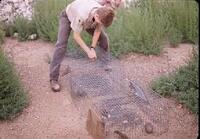Dove Banding Study
Dove Banding Study
Since 2003, biologists in Kansas and 40 other states have banded mourning doves in what has become an ongoing project. The objectives of the banding project are to estimate annual harvest rates (percent of the population shot by hunters) and survival rates (percent of the population surviving one year), and provide information on the geographical distribution of the harvest. In combination with estimates of total harvest from the HIP (Harvest Information Program) survey, banding data can also be used to estimate the size of the mourning dove population. These estimates can be used to monitor trends in mourning dove numbers. This information is needed because mourning doves are such an important migratory game bird and more information is needed to better guide harvest-management decisions. Information on dove survival and harvest rates are keys to understanding the effects of annual hunting regulations on mourning dove populations. Banding is the primary tool used to obtain this information.
Doves are marked with metal leg bands containing a unique number and a toll free 1-800 telephone number and an internet address that hunters can use to report the band. In return, wildlife managers receive important information on the number of banded doves harvested and location and date of harvest. To date, over 11,000 doves have been banded in Kansas and over 300 Kansas-banded doves have been shot by hunters and reported to the Bird Banding Lab. Over 70% of these doves were shot in Kansas..
In Kansas, mourning doves are captured in wire ground traps baited with millet, sunflower, or safflower seeds. Doves enter the trap through the funnels in search of the grain, but cannot get out because of the trap’s design. Traps are checked regularly and trapped doves are removed and carefully examined to determine their age and sex based upon feather color and patterns of feather replacement and wear. Doves are then banded with U.S. Fish and Wildlife Service bands inscribed with unique numbers, the 1-800 telephone number, and an internet address and immediately released.
The hunter is a critical link in this mourning dove banding study. By checking all harvested doves for bands, and reporting banded doves, you help us manage this important migratory game bird resource. Because dove bands are very small, hunters can easily overlook them. We are asking dove hunters to carefully check all doves harvested for the presence of a leg band. If you harvest a banded mourning dove, please call 1-800-327-BAND (2263) or go to the Bird Banding Laboratory website. Hunters can keep the band and will be provided a certificate identifying the age, sex, date, and location the bird was banded.












